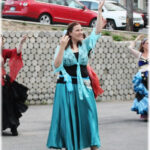The internet is a vast and peculiar place, filled with cultural artifacts that often defy explanation. Among these digital relics, the Dancing Baby Meme stands out as a uniquely persistent and strangely captivating phenomenon. For those unfamiliar, the Dancing Baby, also known as the “Oogachaka Baby,” is a 3D-rendered animation of a baby dancing – and it’s been inexplicably popular for decades. But its enduring appeal takes on another layer of intrigue with the bizarre case of the “Dancing Baby Hotel.”
This story begins with a simple, almost unbelievable online observation. In May 2019, a Tumblr user, ejacutastic, recounted driving past a hotel and being stunned by what they saw on its digital message board: the Dancing Baby GIF, playing on repeat.
This seemingly random sighting sparked a wave of online reactions and a quest to understand why a hotel would feature this decades-old meme on its signage. The Dancing Baby itself has a history as rich and strange as its continued online presence. Created in the mid-1990s by Michael Girard, it was initially a demo for animation software. As Girard himself explained to CNN in 1998, “The dancing baby…actually goes back to an initial cha-cha motion that I created as a demo file years ago” for his Kinetix Character Studio software. Even in its early days, the Dancing Baby was recognized as something culturally significant. Janelle Brown, a culture writer for Wired News in 1998, already identified it as a “meme,” defining it as a “contagious idea.”
From Software Demo to Pop Culture Icon: The Dancing Baby’s Unexpected Rise
The Dancing Baby quickly transcended its origins as a tech demo to infiltrate mainstream culture. Its most notable appearance was on the popular television show Ally McBeal. In the show, the baby was used as a recurring visual metaphor for the protagonist’s biological clock, dancing alongside Ally in surreal sequences. This exposure catapulted the Dancing Baby into widespread recognition, solidifying its place in the late 90s zeitgeist and further cementing its status as an early internet meme.
Beyond Ally McBeal, the Dancing Baby became a ubiquitous presence online. Its simple animation and absurd charm made it endlessly shareable, predating the viral video era but embodying the same spirit. The meme’s appeal lies partly in its simplicity – a baby dancing in a void. This void, initially a product of technological limitations, ironically became a defining aesthetic feature, adding to the meme’s surreal and humorous nature.
The Dallas Enigma: Discovering the Dancing Baby Hotel
The Tumblr post about the “Dancing Baby Hotel” took the meme’s story into an unexpected real-world dimension. The user ejacutastic’s initial post was met with incredulity and then confirmation from another user who identified the location: The Sterling Hotel in Dallas. This wasn’t a one-time glitch; apparently, the Dancing Baby GIF was a permanent fixture on the hotel’s sign.
Intrigued, another Tumblr user, pinchahs, verified the claim with shaky cam footage of the sign in action, further fueling the online fascination.
The GIF even seemed to depict an updated version of the baby, possibly incorporating moves from “Gangnam Style,” suggesting a deliberate and ongoing commitment to the meme by the hotel. Online comments poured in, ranging from humorous observations about the meme’s god-like status to shared memories of encountering Dancing Baby signage elsewhere. Some recalled seeing it on carpet store signs or security company displays, highlighting the meme’s surprisingly widespread, albeit often unexplained, use in advertising and public displays.
Investigating the Mystery: Why the Dancing Baby Hotel?
Despite the online buzz, concrete information about the Dancing Baby Hotel remained elusive. A cursory search revealed no Instagram photos geotagged at the Sterling Hotel featuring the sign, and reviews on Yelp and TripAdvisor made no mention of it. However, digging deeper uncovered a few older tweets, suggesting the sign’s on-again, off-again presence, further adding to the mystique.
Street View reconnaissance confirmed the hotel’s location and the sign’s existence, situated prominently for drivers on the John W. Carpenter Freeway. Yet, the crucial question persisted: Why? Why would a hotel in Dallas choose to display the Dancing Baby meme on its digital sign?
To get to the bottom of this, a direct approach was taken – a phone call to the Sterling Hotel. The conversation, as recounted in the original article, went as follows:
Hi, this is uuuuuhh a weird question but does the hotel have a screen on the side of it playing a GIF of a dancing baby?
[two-second pause that feels like an eternity] Yes, sir.
Okay, and, um, would you happen to know why that is?
I’m not sure, I only just started working here.
Got it. And is it playing the dancing baby 24/7?
In the times that I’ve looked at it, it’s always been a dancing baby.
The phone call confirmed the sign’s existence but yielded no explanation for its presence. The Sterling Hotel is owned by The Mian Companies, whose website, seemingly as dated as the meme itself, offered no clues. The mystery of the Dancing Baby Hotel remains unsolved.
The Enduring Appeal of a Digital Oddity
The Dancing Baby meme’s longevity and the bizarre case of the Dancing Baby Hotel highlight the internet’s capacity to keep seemingly random cultural artifacts alive. Perhaps the meme’s enduring appeal lies in its inherent absurdity, its nostalgic connection to the early days of the internet, or simply its undeniable, if somewhat unsettling, charm. Whatever the reason, the Dancing Baby continues to dance its way through the digital landscape, occasionally popping up in unexpected places like a hotel sign in Dallas, reminding us of the internet’s wonderfully weird and often inexplicable nature. The mystery of why the Sterling Hotel chose this particular meme may never be fully solved, but perhaps that’s part of the Dancing Baby’s enduring magic.

